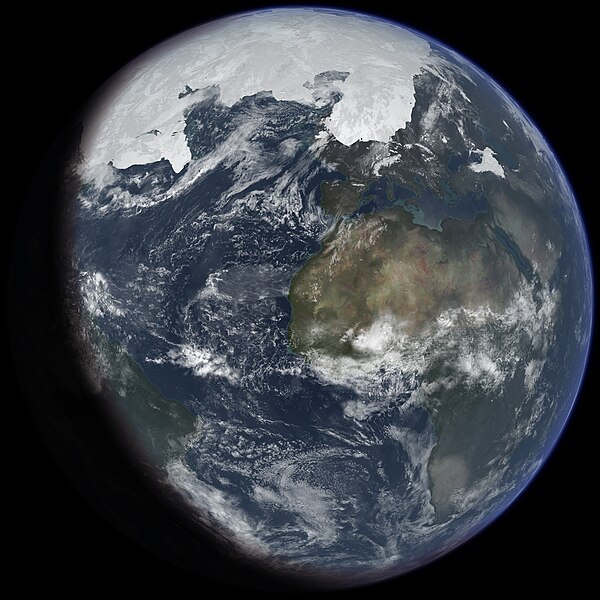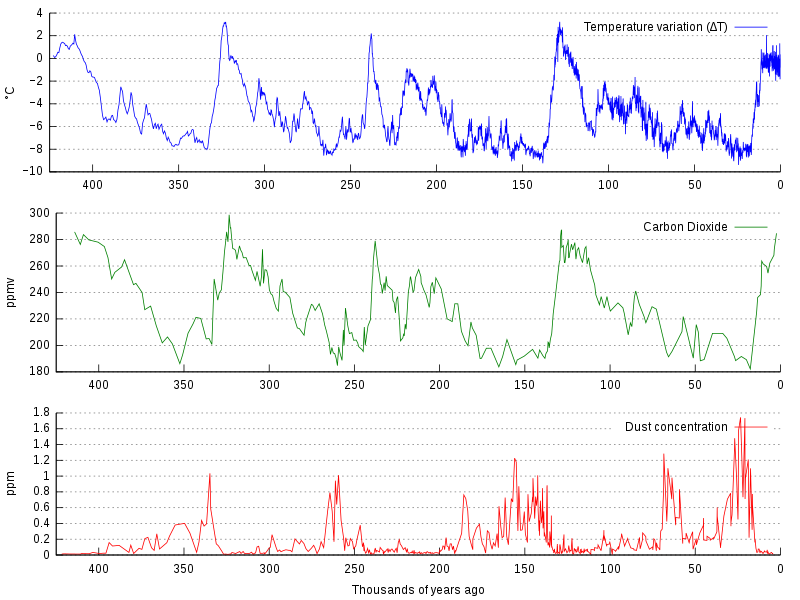|
Lisa Wolfe
|
 |
« on: September 24, 2010, 01:22:38 pm » |
|
An "ice age" or, more precisely, "glacial age" is a generic geological period of long-term reduction in the temperature of the Earth's surface and atmosphere, resulting in the presence or expansion of continental ice sheets, polar ice sheets and alpine glaciers. Within a long-term ice age, individual pulses of extra cold climate are termed "glacial periods" (or alternatively "glacials" or "glaciations"), and intermittent warm periods are called "interglacials". Glaciologically, ice age implies the presence of extensive ice sheets in the northern and southern hemispheres;[1] by this definition we are still in the ice age that began at the start of the Pleistocene (because the Greenland and Antarctic ice sheets still exist).[2]
More colloquially, "the ice age" refers to the most recent colder period that peaked at the Last Glacial Maximum approximately 20,000 years ago, in which extensive ice sheets lay over large parts of the North American and Eurasian continents. This article will use the term ice age in the former, glaciological, sense: glacials' for colder periods during ice ages and interglacials for the warmer periods.
|
|
|
|
|
|


|
|
Lisa Wolfe
|
 |
« Reply #1 on: September 24, 2010, 01:23:22 pm » |
|
 An artist's impression of ice age Earth at glacial maximum. Based on: "Ice age terrestrial carbon changes revisited" by Thomas J. Crowley (Global Biogeochemical Cycles, Vol. 9, 1995, pp. 377-389 |
|
|
|
|
|
|
|
Lisa Wolfe
|
 |
« Reply #2 on: September 24, 2010, 01:24:13 pm » |
|
 A photograph of the snow surface at Dome C Station, Antarctica, it is representative of the majority of the continent's surface. The photo was taken from the top of a tower, 32 m above the surface |
|
|
|
|
|
Lisa Wolfe
|
 |
« Reply #3 on: September 24, 2010, 01:24:54 pm » |
|
 La bildo estas kopiita de wikipedia:en. La originala priskribo estas: Graph of CO2 (Green graph), temperature (Blue graph), and dust concentration (Red graph) measured from the Vostok, Antarctica ice core as reported by Petit et al., 1999. Higher dust levels are believed to be caused by cold, dry periods. |
|
|
|
|
|
Lisa Wolfe
|
 |
« Reply #4 on: September 24, 2010, 01:30:58 pm » |
|
Origin of ice age theory
In 1742 Pierre Martel (1706–1767), an engineer and geographer living in Geneva, visited the valley of Chamonix in the Alps of Savoy.[3][4] Two years later he published an account of his journey. He reported that the inhabitants of that valley attributed the dispersal of erratic boulders to the fact that the glaciers had once extended much farther.[5][6] Later similar explanations were reported from other regions of the Alps. In 1815 the carpenter and chamois hunter Jean-Pierre Perraudin (1767–1858) explained erratic boulders in the Val de Bagnes in the Swiss canton of Valais as being due to glaciers previously extending further.[7] An unknown woodcutter from Meiringen in the Bernese Oberland advocated a similar idea in a discussion with the Swiss-German geologist Jean de Charpentier (1786–1855) in 1834.[8] Comparable explanations are also known from the Val de Ferret in the Valais and the Seeland in western Switzerland[9] and in Goethe's Scientific Work.[10] Such explanations could also be found in other parts of the world. When the Bavarian naturalist Ernst von Bibra (1806–1878) visited the Chilean Andes in 1849–1850 the natives attributed fossil moraines to the former action of glaciers.[11]
Meanwhile, European scholars had begun to wonder what had caused the dispersal of erratic material. From the middle of the 18th century some discussed ice as a means of transport. The Swedish mining expert Daniel Tilas (1712–1772) was, in 1742, the first person to suggest drifting sea ice in order to explain the presence of erratic boulders in the Scandinavian and Baltic regions.[12] In 1795, the Scottish philosopher and gentleman naturalist, James Hutton (1726–1797), explained erratic boulders in the Alps with the action of glaciers.[13] Two decades later, in 1818, the Swedish botanist Göran Wahlenberg (1780–1851) published his theory of a glaciation of the Scandinavian peninsula. He regarded glaciation as a regional phenomenon.[14] Only a few years later, the Danish-Norwegian Geologist Jens Esmark (1763–1839) argued a sequence of worldwide ice ages. In a paper published in 1824, Esmark proposed changes in climate as the cause of those glaciations. He attempted to show that they originated from changes in the Earth's orbit.[15] During the following years, Esmark’s ideas were discussed and taken over in parts by Swedish, Scottish and German scientists. At the University of Edinburgh Robert Jameson (1774–1854) seemed to be relatively open towards Esmark's ideas. Jameson's remarks about ancient glaciers in Scotland were most probably prompted by Esmark.[16] In Germany, Albrecht Reinhard Bernhardi (1797–1849), professor of forestry at Dreissigacker, adopted Esmark's theory. In a paper published in 1832, Bernhardi speculated about former polar ice caps reaching as far as the temperate zones of the globe.[17]
|
|
|
|
|
|
Lisa Wolfe
|
 |
« Reply #5 on: September 24, 2010, 01:31:20 pm » |
|
Independently of these debates, the Swiss civil engineer Ignaz Venetz (1788–1859) in 1829, explained the dispersal of erratic boulders in the Alps, the nearby Jura Mountains and the North German Plain as being due to huge glaciers. When he read his paper before the Schweizerische Naturforschende Gesellschaft, most scientists remained sceptical.[18] Finally, Venetz managed to convince his friend Jean de Charpentier. De Charpentier transformed Venetz's idea into a theory with a glaciation limited to the Alps. His thoughts resembled Wahlenberg's theory. In fact, both men shared the same volcanistic, or in de Charpentier’s case rather plutonistic assumptions, about earth history. In 1834, de Charpentier presented his paper before the Schweizerische Naturforschende Gesellschaft.[19] In the meantime, the German botanist Karl Friedrich Schimper (1803–1867) was studying mosses which were growing on erratic boulders in the alpine upland of Bavaria. He began to wonder where such masses of stone had come from. During the summer of 1835 he made some excursions to the Bavarian Alps. Schimper came to the conclusion that ice must have been the means of transport for the boulders in the alpine upland. In the winter of 1835 to 1836 he held some lectures in Munich. Schimper then assumed that there must have been global times of obliteration (“Verödungszeiten“) with a cold climate and frozen water.[20] Schimper spent the summer months of 1836 at Devens, near Bex, in the Swiss Alps with his former university friend Louis Agassiz (1801–1873) and Jean de Charpentier. Schimper, de Charpentier and possibly Venetz convinced Agassiz that there had been a time of glaciation. During Winter 1836/7 Agassiz and Schimper developed the theory of a sequence of glaciations. They mainly drew upon the preceding works of Venetz, of de Charpentier and on their own fieldwork. There are indications that Agassiz was already familiar with Bernhardi's paper at that time.[21] At the beginning of 1837 Schimper coined the term ice age (“Eiszeit“).[22] In July 1837 Agassiz presented their synthesis before the annual meeting of the Schweizerische Naturforschende Gesellschaft at Neuchâtel. The audience was very critical or even opposed the new theory because it contradicted the established opinions on climatic history. Most contemporary scientist thought that the earth had been gradually cooling down since its birth as a molten globe.[23]
In order to overcome this rejection, Agassiz embarked on geological fieldwork. He published his book Study on glaciers ("Études sur les glaciers") in 1840.[24] De Charpentier was put out by this as he had also been preparing a book about the glaciation of the Alps. De Charpentier felt that Agassiz should have given him precedence as it was he who had introduced Agassiz to in depth glacial research.[25] Besides that, Agassiz had, as a result of personal quarrels, omitted any mention of Schimper in his book.[26]
Altogether, it took several decades until the ice age theory was fully accepted. This happened on an international scale in the second half of the 1870s.[27]
|
|
|
|
|
|
Lisa Wolfe
|
 |
« Reply #6 on: September 24, 2010, 01:31:52 pm » |
|
Evidence for ice ages
There are three main types of evidence for ice ages: geological, chemical, and paleontological.
Geological evidence for ice ages comes in various forms, including rock scouring and scratching, glacial moraines, drumlins, valley cutting, and the deposition of till or tillites and glacial erratics. Successive glaciations tend to distort and erase the geological evidence, making it difficult to interpret. Furthermore, this evidence was difficult to date exactly; early theories assumed that the glacials were short compared to the long interglacials. The advent of sediment and ice cores revealed the true situation: glacials are long, interglacials short. It took some time for the current theory to be worked out.
The chemical evidence mainly consists of variations in the ratios of isotopes in fossils present in sediments and sedimentary rocks and ocean sediment cores. For the most recent glacial periods ice cores provide climate proxies from their ice, and atmospheric samples from included bubbles of air. Because water containing heavier isotopes has a higher heat of evaporation, its proportion decreases with colder conditions.[28] This allows a temperature record to be constructed. However, this evidence can be confounded by other factors recorded by isotope ratios.
The paleontological evidence consists of changes in the geographical distribution of fossils. During a glacial period cold-adapted organisms spread into lower latitudes, and organisms that prefer warmer conditions become extinct or are squeezed into lower latitudes. This evidence is also difficult to interpret because it requires (1) sequences of sediments covering a long period of time, over a wide range of latitudes and which are easily correlated; (2) ancient organisms which survive for several million years without change and whose temperature preferences are easily diagnosed; and (3) the finding of the relevant fossils, which requires a lot of luck.
Despite the difficulties, analyses of ice core and ocean sediment cores has shown periods of glacials and interglacials over the past few million years. These also confirm the linkage between ice ages and continental crust phenomena such as glacial moraines, drumlins, and glacial erratics. Hence the continental crust phenomena are accepted as good evidence of earlier ice ages when they are found in layers created much earlier than the time range for which ice cores and ocean sediment cores are available.
|
|
|
|
|
|
|
|


